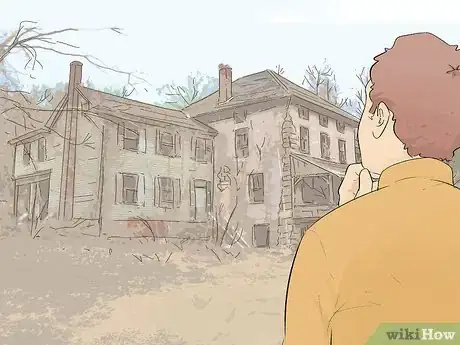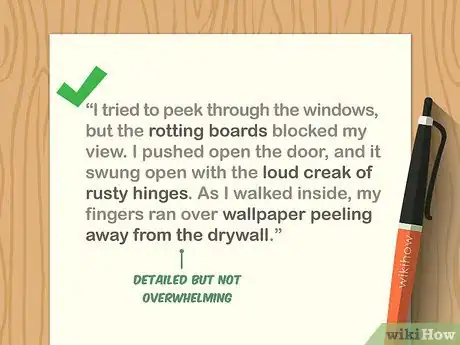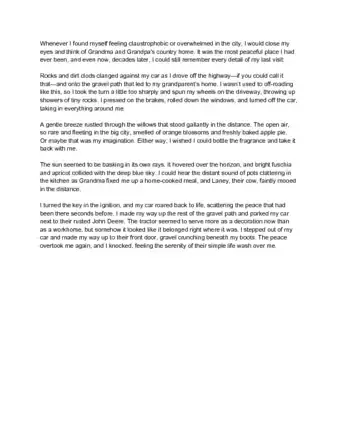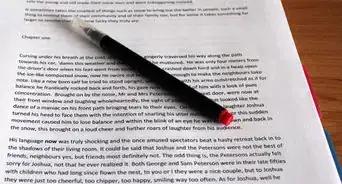This article was co-authored by Lucy V. Hay and by wikiHow staff writer, Hunter Rising. Lucy V. Hay is a Professional Writer based in London, England. With over 20 years of industry experience, Lucy is an author, script editor, and award-winning blogger who helps other writers through writing workshops, courses, and her blog Bang2Write. Lucy is the producer of two British thrillers, and Bang2Write has appeared in the Top 100 round-ups for Writer’s Digest & The Write Life and is a UK Blog Awards Finalist and Feedspot’s #1 Screenwriting blog in the UK. She received a B.A. in Scriptwriting for Film & Television from Bournemouth University.
There are 9 references cited in this article, which can be found at the bottom of the page.
This article has been viewed 1,086,877 times.
The setting of a story is the environment your characters are in. The location, time, and weather all play major points in a story, and a well-described setting can make it more interesting for your readers to completely immerse themselves in the fictional world you’ve created. When you describe your setting, use detailed language and have your characters interact with it to engage your readers. When you have a detailed setting, your story will come to life!
Steps
Creating a Detailed Setting
-
1Incorporate the 5 senses to your description. Using touch, taste, sight, sound, and smell can add immersive details to your story that helps readers put themselves in your character’s shoes. Think about the setting you’ve created and make a list of the specific sensory details your character would experience in the location.[1]
- For example, if your setting is the beach, you could describe the feeling of sand between your character’s toes, the taste the salt in the air, the sound of the waves, the briny smell of the water, and the shape of the sand dunes.
- If you want to be a professional writer, you should outline first.
- It helps to write novels fast.[2]
- It cuts down the problem areas in the plot and makes work easier.[3]
-
2Visit a location similar to your setting if you can to experience it for yourself. If you’re basing your story in a real-life location, take a trip to the place so you can pick out specific details. Keep a small notebook and pen with you and write down what you’re experiencing. Incorporate those details into your story to give it more authenticity.
- If you can’t visit the location yourself, research online for firsthand accounts of people in the area. Pull details from what they’ve experienced, but be sure not to plagiarize them.
Advertisement -
3Look at photographs of a similar setting for inspiration on specific details. If you’re having trouble imagining your setting, search for pictures online of similar locations. Look for small details in the pictures that you could include in your own story. Save the pictures and write a few of the details down so you don’t forget about them.[4]
- If you’re writing about a real-life location, use Google Street View to look at the area to pull even more specific details.
- Look on websites like Artstation and Pinterest if you’re writing about a made-up universe to get visual inspiration for what your setting could look like.
- Mix real-life details with your imagination to make the setting specific to your story.
-
4Include references to give clues to the time your story takes place. If you’re writing a story that takes place in the past, research real events that took place that you can incorporate in your story. Try to incorporate at least 1-2 references of the time period, such as technology, clothing, and the culture, so your reader gets immersed in your story.[5]
- For example, if you’re writing a story that takes place soon after World War II, you may say, “The planes tore through the city, leaving piles of burnt rubble where our houses used to be,” to reference how a battle affected the town’s landscape.
Incorporating Details into Your Story
-
1Choose 3-4 main details to focus on to create a feeling for the space. Too many details could be overwhelming to your reader and they could cause your story to slow down. Choose a few major details of the location that your character might interact with and incorporate them in your writing.
- For example, if you’re describing an abandoned house, you might focus on the wallpaper peeling off of the walls, broken stairs leading to the second floor, and how the windows are covered with rotting boards.
-
2Spread the details throughout your writing to avoid long paragraphs. Avoid writing 1 paragraph that explains the setting since readers may skip it if there isn’t any action happening. Instead, mention a few details at the beginning of the paragraph followed by your character’s actions. If you need more detail in the paragraph, include more near the end of the paragraph.[6]
- For example, if you’re writing about an abandoned house like before, you may write, “I tried to peek through the windows, but the rotting boards blocked my view. I pushed open the door, and it swung open with the loud creak of rusty hinges. As I walked inside, my fingers ran over wallpaper peeling away from the drywall.” This way, details are conveyed throughout the paragraph without being overwhelming.
-
3Use metaphors and similes to create figurative descriptions of your setting. Many setting descriptions of setting talk about what the character is literally experiencing, but using figurative language can help readers make connections easier. Compare something in your setting to something else to help convey a mood for your setting.[7]
- For example, you may write something like, “The wires covered the basement floor, like vines waiting to ensnare me in their trap,” to convey how dense the wires are in a basement.
An Example of Figurative Description
Small flames stirred at the trunk of a tree and crawled away through leaves and brushwood, dividing and increasing. One patch touched a tree trunk and scrambled up like a bright squirrel. The smoke increased, sifted, rolled outwards. The squirrel leapt on the wings of the wind and clung to another standing tree, eating downwards.
William Golding, Lord of the Flies
Connecting Setting to Characters
-
1Avoid over-describing settings that don’t matter to the characters. Backdrop settings are not important to the story, so don’t include too many details to describe it. Integral settings, however, influence how your character responds and reacts to their environment. Put more time and focus on details for settings that are important to your characters.[8]
- For example, if your character is walking down a street and having a conversation, it’s not important to include detailed descriptions. However, if your story involves a car accident, you might add descriptions like a streetlight that’s flickering or a stop sign that was stolen.
- Try to have most, if not all, of the settings in your story integral settings for your character.
-
2Describe how your character interacts with the setting to keep your story moving. Commonly referred to as “show, don’t tell,” explain how your character moves throughout your setting while including small details. This will make your story and descriptions more exciting and engaging for your readers.[9]
- For example, instead of writing, “A log was in front of her. She tripped over it,” you may write something like, “As she rushed through the dark forest path, her foot caught on a log and she fell into the tall grass.”
-
3Write about how a change in setting affects your characters. Settings should create different emotions in your character. Use weather and time of day to match how your character is feeling, or change the setting suddenly and describe how it changes your character’s mood.[10]
- For example, if your character is sad you may say, “As she wiped the tears off her cheek, the sun disappeared and a slow patter of rain started to thrum on the pavement. A gust of cold wind blew right through her.”
-
4Use setting to help express your character’s feelings or the story’s theme. Theme and setting have an important connection in your story, so make sure they relate to one another. Consider the theme of your story, and work in specific details about the setting to make them reflect one another.[11]
- For example, if your story is about someone learning to love another person, you could have the setting change from winter to summer to convey the message that your characters are warming up to one another.
An Example of Setting Conveying Emotion
The deep green pool of the Salinas River was still in the late afternoon. Already the sun had left the valley to go climbing up the slopes of the Gabilan Mountains, and the hilltops were rosy in the sun. But by the pool among the mottled sycamores, a pleasant shade had fallen.
In this excerpt from the end of John Steinbeck's Of Mice and Men, the riverbank is a place of comfort for Lennie.
Sample Setting Descriptions
Community Q&A
-
QuestionCan I use the characters from my favorite TV show in my story?
 Community AnswerYes, and that's usually called "fanfiction."
Community AnswerYes, and that's usually called "fanfiction." -
QuestionHow do I describe a village in a story?
 Community AnswerThere are many rich details you can go into for a village. The time period it's set in as well as the location. How big is it, what are the houses made of - unbaked bricks and aluminum shutters, mud houses with thatched roofs? What's the climate like and how does that determine the terrain - arid with dry sand patches and dull looking plants, spotted in lonely patches, or a lush tropical climate with rich, dark mud, and tall, imposing trees? What's the population; what are the people like, is there a social hierarchy - respected village elders? Tyrant feudal lord? Friendly, caring, community-feel, or hungry, greedy, always competing with one another, etc.?
Community AnswerThere are many rich details you can go into for a village. The time period it's set in as well as the location. How big is it, what are the houses made of - unbaked bricks and aluminum shutters, mud houses with thatched roofs? What's the climate like and how does that determine the terrain - arid with dry sand patches and dull looking plants, spotted in lonely patches, or a lush tropical climate with rich, dark mud, and tall, imposing trees? What's the population; what are the people like, is there a social hierarchy - respected village elders? Tyrant feudal lord? Friendly, caring, community-feel, or hungry, greedy, always competing with one another, etc.? -
QuestionCan I use my home town in the country?
 Community AnswerYes, you can. By using a real town, it makes the story or setting sound real. Just be careful to not say anything bad about people that could identify them for real or they may claim that you have defamed them.
Community AnswerYes, you can. By using a real town, it makes the story or setting sound real. Just be careful to not say anything bad about people that could identify them for real or they may claim that you have defamed them.
Warnings
- Be careful not to over-describe every detail or else your story may be too dense and bore your readers.⧼thumbs_response⧽
References
- ↑ https://writersedit.com/fiction-writing/use-all-five-senses-unlock-fictional-world/
- ↑ https://mythicscribes.com/writing-process/benefits-of-outlining/
- ↑ https://mythicscribes.com/writing-process/benefits-of-outlining/
- ↑ https://www.teachwriting.org/blog/2017/12/19/descriptive-writing-lesson-a-winter-setting
- ↑ https://www.rcboe.org/cms/lib010/GA01903614/Centricity/Domain/4395/Elements%20of%20a%20Story.pdf
- ↑ https://blog.reedsy.com/setting-of-a-story/
- ↑ https://writingcooperative.com/writing-tips-using-figurative-language-to-describe-setting-849e8f645ceb
- ↑ https://literarydevices.net/setting/
- ↑ https://blog.reedsy.com/setting-of-a-story/
About This Article
To describe the setting in a story, use all 5 senses to help your readers imagine what you're describing. For example, if your story takes place at a beach, you could describe how the sand feels soft and the air tastes salty. However, try to stick with a few main details so you're not overwhelming your readers, and space your descriptions out throughout your story instead of cramming them into 1 long paragraph. If you need some inspiration, try visiting a location that's similar to your setting or looking up pictures online. For tips on how to use metaphors and similes to describe a setting, scroll down!












































































